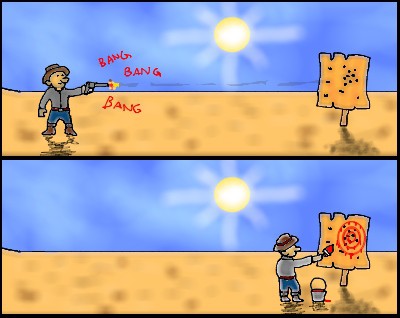

Similarly, when looking at data, there is a danger of jumping to a conclusion that a random cluster is a causal pattern. This fallacy lives up to its striking name because the Texas sharpshooter takes a random cluster, and by drawing a target onto it makes it appear to be causally determined, as if the Texan were shooting at the target.

Patterns in data can be useful for forming hypotheses, but they are not themselves sufficient evidence of a causal connection. For instance, if a disease is contagious, it may be clustered around a carrier.Īt best, the occurrence of a cluster in the data is the basis not for a causal conclusion, but for the formation of a causal hypothesis which needs to be tested. Even if the cluster is not the result of chance, there are other possible reasons for the clustering, other than the cause chosen.The cluster may well be the result of chance, in which case it was not caused by anything.Imagine that you dream of the number seven while you stayed in hotel room number 362 (of which you were previously unaware of). There are two reasons why this is fallacious: Examples of the Texas sharpshooter fallacy To continue understanding the Texas sharpshooter fallacy, here’s an example you could easily find in your daily life. This fallacy occurs when someone jumps to the conclusion that a cluster in some data must be the result of a cause, usually one that it is clustered around. But an epidemiological study ultimately showed that the cancer rate was no greater than that of the general population.
#Texas sharpshooter fallacy examples movie
Hexavalent chromium in the water supply of a small California town was blamed for causing cancer, resulting in a $333 million legal settlement and a movie starring Julia Roberts. … The Erin Brockovich incident, one of the most famous, is among the many that have been debunked. * Example:Įach year…epidemiologists regularly hear from people worried that their town has been plagued with an unusually large visitation. The story of this Lone Star state shooter has given its name to a fallacy apparently first described in the field of epidemiology, which studies how disease spreads in a population. The Texas sharpshooter is a fabled marksman who fires his gun randomly at the side of a barn, then paints a bullseye around the spot where the most bullet holes cluster. Draw a circle around them and you have what looks like a bull’s-eye. …he epidemiologist Seymour Grufferman coined the term “Texas sharpshooter effect.” Stand way back and blast the side of a barn with a shotgun and then find some holes that are crowded together.
#Texas sharpshooter fallacy examples pro
Taxonomy: Logical Fallacy > Informal Fallacy > Non Causa Pro Causa > The Texas Sharpshooter Fallacy


 0 kommentar(er)
0 kommentar(er)
